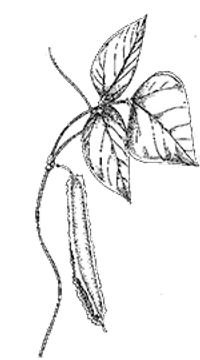- Breadfruit Bread
- Storing Cooked Eggs
- What is the Hot Pepper Aroma...
- Pineapple Juice Shortens Cooking Time of Beans
- Squash Catsup
- Prepare Diffusion-Processed Sweet Potato at Home
- How Are Winged Beans Cooked?
- Winged Bean Recipes
- Food Cycle Technology Sourcebooks
- Book Review: Cultivos Andinos Subexplotados y Su Aporte a la Alimentacion
- Book Review: Manual Sobre Utilizacion de los Cultivos Andinos
BREADFRUIT BREAD. Another interesting item in the UNICEF "From Garden to Kitchen" newsletter (see above) was this recipe for one loaf of bread using 25% (by volume) grated cooked breadfruit and 75% wheat flour (originally from the Methodist Handicraft and Farming School in Fiji). If breadfruit goes to waste where you live, this is a good use and will cut down on need for imported wheat flour.
Sift 1 3/4 cup flour, 3 teaspoons baking powder and a dash of salt. Pound very ripe breadfruit until mushy. Mix 1 1/4 cup breadfruit pulp, 1/3 cup oil, 2 tablespoons of milk, 2 eggs. Add 2/3 cup sugar. Stir into flour mixture, pour into greased pan and bake 1 hour at 350 deg.F (175 deg.C).
STORING COOKED EGGS. Just because eggs can be stored for some time without refrigeration does not mean the same is true of cooked eggs, according to Science News (August 10, 1985). "In its raw state, the egg has several antimicrobial defenses. The cuticle, or outside portion of the shell, protects the eggs from bacterial invasion as long as this layer remains intact." The shell membrane may be an even more resistant barrier for bacteria. Furthermore an enzyme called lysozyme in the shell membrane and in the egg white destroys many bacteria. Cooking not only inactivates the egg's lysozyme, but also enlarges the shell's pores. The most important breakdown in defenses may occur when boiled eggs are cooled in water. The egg's contraction during cooling creates an air pocket which produces a vacuum that can draw in bacteria present in the cooling water.
Eggs that were cooled in water that had been inoculated with botulism spores resulted in the toxin being produced in the eggs. Because botulism bacteria thrive in the absence of oxygen, eggs stored in complete absence of oxygen spoiled first (2-3 days), those in tightly sealed plastic storage containers in a week and those in open air about 8 days.
So keep these three facts in mind: (1) Hard-boiled eggs spoil more quickly than uncooked eggs and should be refrigerated. (2) Cooling in the air may be preferable to cooling in water, especially if the water is not pure. (3) It is better not to store them in air-tight containers.
WHAT IS THE HOT PEPPER AROMA that is released when they are heated in cooking oil? The substance that makes  peppers hot, capsaicin, breaks down into vanillin and some other substances. Vanillin is the main flavor in vanilla. (Abstracted from Organic Gardening, p. 25, April 1993.)
peppers hot, capsaicin, breaks down into vanillin and some other substances. Vanillin is the main flavor in vanilla. (Abstracted from Organic Gardening, p. 25, April 1993.)
PINEAPPLE JUICE SHORTENS COOKING TIME OF BEANS. Amaglo Newton at the University of Science in Kumasi, Ghana is excited about a discovery of one of his masters  students, Viggo Dodoo-Ghana. "For some time I have been working to introduce soybeans to some missionaries. One major problem is the difficult cooking properties of the bean. ...[We now find that] a group of proteolytic enzymes (bromelin) found in pineapple juice is able to digest the outer seedcoat and ease the difficulty of cooking the bean.
students, Viggo Dodoo-Ghana. "For some time I have been working to introduce soybeans to some missionaries. One major problem is the difficult cooking properties of the bean. ...[We now find that] a group of proteolytic enzymes (bromelin) found in pineapple juice is able to digest the outer seedcoat and ease the difficulty of cooking the bean.
"The beans are soaked for 6-10 hours in water to which pineapple juice has been added. It is then easy to peel off the seed coat. The cooking is then easy." [Ed: There is a good chance that the enzyme has been destroyed in canned juice, in which case you would need to make fresh juice.]
A few years ago Roland Bunch told me that women in Guanople, Honduras used papaya leaves when they cooked beans. Apparently papain in the leaves softened the seed coat also. I have no further details. A volunteer tried cooking some beans the way we imagined the process would be, but the taste was so bitter they were inedible.
Both of these approaches might be worth pursuing. A shorter cooking time for beans would both be more convenient for the cook and use less firewood. If you experiment, let us know the results.
SQUASH CATSUP. When I give educational talks, I help the audience visualize the importance of new plant introductions by asking them to imagine what Italian cooking must have been like before the tomato was introduced from the Andes. Where would fast foods be without catsup? This recipe from "From Garden to Kitchen" (see above) stretches my imagination a bit. But many of you work where it is difficult to grow tomatoes. If it works, and you could get used to orange catsup, it might be worth a try. "Squash catsup can be made using squash [or tropical pumpkin] puree cooked with varying amounts of vinegar, salt, pepper, sugar and other spices. Corn flour is used as a binder and thickener." Presumably winter squash or tropical pumpkin would be interchangeable.
Another interesting squash/pumpkin recipe is suggested. "Mix 7 parts of squash puree and 3 parts corn flour then form into chips and dry. Later they are deep fried in oil...."
PREPARE DIFFUSION-PROCESSED SWEET POTATO AT HOME. Dr. Frank Martin is a research specialist in sweet potato breeding. He writes, " A persistent nagging question is why people don't eat and don't want to eat more sweet potatoes. We believe this is due to sweetness itself, as well as flavors and textures that are not liked. We developed a new product that anyone can make at home that is less sweet, of more agreeable texture, and of better flavor than most sweet potatoes. People who don't like sweet potatoes do like our product. Please try this recipe in your kitchen and let us know what you think: (1) Peel the sweet potato and eliminate any bad spots. (2) Cut very carefully into slices about 1/8" (3mm) thick. (3) Cover the slices with water. Leave for two hours, moving slices 3-4 times so that all sides are exposed to the water. (4) Discard the water and rinse. (5) Boil 20 minutes. (6) Discard the water. (7) Mash. At this time salt, milk or margarine can be added. (8) Serve mixed with mayonnaise or salad dressings, beans or bean sauce, meats or gravy, or mixed into soups. It can also be molded into patties and fried. The product is best used fresh, and should not be stored for long periods."
 HOW ARE WINGED BEANS COOKED? Peace Corps volunteer Henry Kobie in Liberia wrote that he has had considerable success introducing winged beans, but folks know little about how to cook them. I thought our readers might be interested in what we turned up for him. I have often wondered why a plant that has received so much attention, because of its potential both for production in hot humid climates and also for its high nutritional value, is not making a greater global impact. Uncertainty on how to use it is no doubt part of the problem.
HOW ARE WINGED BEANS COOKED? Peace Corps volunteer Henry Kobie in Liberia wrote that he has had considerable success introducing winged beans, but folks know little about how to cook them. I thought our readers might be interested in what we turned up for him. I have often wondered why a plant that has received so much attention, because of its potential both for production in hot humid climates and also for its high nutritional value, is not making a greater global impact. Uncertainty on how to use it is no doubt part of the problem.
The most difficult question is how to prepare the mature seeds. A few years ago I asked a researcher at CIAT in Colombia why they were not eaten on a large scale. He said that if I had ever tasted them I would know! The long cooking time required to soften whole, mature beans is also a problem in firewood-short countries. I think we can take a lesson from the soybean. In the countries where soybean is an important food, they have developed rather elaborate and unusual processing methods (making "milk", tempeh, etc.). The winged bean seed is nutritionally comparable to the soybean and, I suspect, requires similar processing methods.
A friend here in town makes a spread from ground up mature winged bean seeds that I quite enjoyed. He adapted this and other recipes from soybean recipes in "Recipes for a Small Planet." Perhaps you could adapt it to local conditions, at least for the palates of our American readers. The ingredients are 2/3 c dry beans cooked until tender, a large onion sauteed in oil with a bit of garlic, juice of 2 lemons, a tablespoon soy sauce, 1/4 cup sesame butter (or any nut butter), 1/2 cup roasted and ground sesame seed, and 1/2 tsp salt.
The National Academy of Sciences' most recent booklet on the "Winged Bean: A High Protein Crop for the Tropics" (1981) is quite helpful. The following are excerpts adapted from that booklet, with my comments in [ ]. Pods are the most popular part of the plant in most countries where the bean is grown and the easiest to introduce as food. They can be eaten raw or used in salads, soups, stews and curries and may be boiled in water or coconut milk or sauteed in oil. [If you grasp the pod in both hands it should be flexible. If not it will be too stringy to eat. Varieties differ in how long pods can grow before becoming fibrous.] In Papua New Guinea, pods that are too fibrous to eat whole are often steamed in oil drums or the "mumu" pit, or baked in open fires; the seeds and mucilage are then scraped out and eaten. [This is probably of higher nutritional value because protein accumulates as the pods mature.] Alternatively, the half-ripe seeds can be removed from the pod and cooked. The immature pod provides primarily bulk with comparatively low energy content, but is valuable for the minerals and vitamins. No adverse effects have been reported from cooked immature pods. [A missionary recently told me that he required his workers to eat at least one raw bean at the beginning of each day. They were seriously under- nourished. They soon began feeling so much better that they ate it on their own and requested seed.]
The seeds are the most nutritious part. They can be steamed, boiled, fried, roasted, fermented, or made into milk, tofu (bean curd) or tempeh. Because of antinutritional substances, they should be soaked overnight, then boiled in water until tender, with the soaking liquid discarded. [I understand that some varieties from regions that grow winged beans primarily for tubers may have more toxic substances present in the seeds, so be cautious if collecting your own varieties in such places.] If seeds are soaked in a hot, 1-percent sodium bicarbonate [as in Arm and Hammer soda] solution, the hard seed coats are more easily removed. Mature seeds are more difficult to dehull by this process because the cotyledons swell and press firmly against the hull. When fried or baked, they make a delicious nut-like snack. The high temperature breaks open the tough seed coat. It is not certain, however, whether this method of cooking removes the antinutritional substances. Sprouted winged bean seed can be used as an alternative to mung bean sprouts. Extracting oil from winged bean seeds leaves a high-protein meal. Infants fed winged bean meal suffer little or no flatulus discomfort [gas]. In storage the seeds show remarkable resistance to bruchid beetles which are such a bad pest of stored legumes.
Tubers have several times the protein of potatoes. They can be boiled, steamed, fried or baked. The brown skin peels off readily after 40 minutes of cooking, leaving a white or cream-colored flesh that is firm and moist, with a distinctive nutty, earthy flavor. They are always eaten cooked.
Winged bean sprouts and shoots may be eaten raw or cooked as green vegetables. The top three sets of leaflets are the most tender; they taste slightly sweet. They have an average amount of protein, but are exceptionally high in the amino acid tryptophan. Thus even a small amount of the leaves can greatly improve tryptophan-deficient diets, e.g. those based on corn. Adding cooked leaves to diets of weaned infants and preschool children is recommended for the minerals and vitamin A precursor. The latter is among the highest ever recorded in green leaves of tropical plants. Excessive consumption of raw leaves has produced dizziness, nausea and flatulence, so large amounts of raw leaves should not be encouraged. Properly cooked they are safe in quantity. Also flowers can be eaten raw. When steamed or fried they have the color and consistency of mushrooms.
Commercial efforts were just getting underway when the book was published. Efforts are underway to make flour. A gruel for weaning infants has been produced in Ghana. Mixed with corn, it provides the nutritive equivalent of milk. In Thailand a similar gruel made of winged bean meal, rice, and banana is being fed to refugees from Cambodia. Because of its similarity to the soybean, many soybean recipes are being tried. Tempeh and tofu are made commercially in Indonesia. Both white milk and a chocolate-flavored milk have been made from the seed in Thailand and sterilized for longer shelf life. Researchers have made tasty snacks from tubers sliced thin, fried and salted, or softened in sugar syrup. Immature pods are used in pickles commercially in South India. One researcher in Indonesia has made a coffee substitute by roasting the seed (the grounds are edible) and a tobacco substitute from the dried leaf. Both of these should be free of alkaloids.
By the way, the dry pod left after threshing contains 10% protein and has been tested satisfactorily in animal feeds. In Thailand this pod residue is being used successfully as a medium for growing straw mushrooms.
Let me know if you are able to adapt any of these ideas and what the people's reactions are. We would be especially interested to know of any successful introductions you have made and how the local people prepare them. Winged beans are native to hot, humid tropical regions. If you have had success introducing them into other climates we would especially like to know the details (e.g. in dry or high altitude regions).
WINGED BEAN RECIPES. Dr. Andy Duncan sent us several recipes; write us for a photocopy. Dr. Frank Martin sent this information on winged bean seeds: "Probably no region of the tropics uses the seeds regularly as food. Seeds are parched in Java, but probably only immature seeds are used. They are used for making a vegetable curd similar to tofu from soybean, but our experience showed that such curds are definitely inferior to those of soybean. The 4-hour cooking time is an obstacle [to use of the seed]. ...The heavy seed has been suggested to cause abdominal pain. The evidence is persuasive that dry winged bean seeds are difficult to eat."
This was "confirmed in tests of 20 different lines.... Seeds left to soak absorbed water slowly, and some not at all. Three or four hours were required to cook soaked beans, and then some remained hard and unswollen. Cooked beans were harsh and nut-like, acceptable as an occasional food, but not attractive to the eye or the palate. When cooked beans were ground into soups and flavored with other ingredients, an acceptable product was obtained. Although variety differences were seen, these were not sufficient to permit selection of lines of acceptable value."
four hours were required to cook soaked beans, and then some remained hard and unswollen. Cooked beans were harsh and nut-like, acceptable as an occasional food, but not attractive to the eye or the palate. When cooked beans were ground into soups and flavored with other ingredients, an acceptable product was obtained. Although variety differences were seen, these were not sufficient to permit selection of lines of acceptable value."
Frank suggested a different method of cooking. "The beans treated in this fashion are very soft. Even the seed coats are pliable and edible. Such beans have a mild and agreeable flavor comparable to that of other beans. Tests so far suggest that people who eat beans regularly accept them readily. [They can be] used in many traditional dishes. Not all varieties are equally suited to this technique. In many, a few seeds remain hard, and many are intermediate. In these lines, however, the softened seeds can be separated from the hard seeds with a large mesh screen. Here is that better method:
"Measure the volume of beans to be cooked. Rinse and add 5 volumes of water. To the water add 1% sodium bicarbonate sold as soda or baking powder [about 1/2 teaspoon per cup of water]. Boil the beans and simmer for 3 minutes. Remove from heat and soak the beans in the solution overnight. The following day, discard the soaking water, rinse twice with fresh water and boil in double their volume of fresh water for 20 to 25 minutes."
FOOD CYCLE TECHNOLOGY SOURCEBOOKS are eleven well-illustrated manuals (40-70 pages) which discuss different aspects of food processing, both traditional practices from around the world and modern equipment and techniques. With specific, basic information on technology choice for individuals and small businesses, they are most relevant for people who introduce innovations in food processing. Each book has a helpful checklist for planning your project or enterprise before you begin.
 Most ideas involve a purchased technology upgrade, suitable for medium-scale processing with commercial potential. However, interesting and simple local technologies are also included. For example, the book on Root Crop Processing mentions the "wedge press, an adaptation of a traditional Chinese press used to extract oil. Tree stumps or logs provide support for a wooden beam inserted between them [see drawing]. Sacks of grated pulp are placed on the beam and pressure is applied when wooden wedges are hammered into the space between the sacks and tree stump."
Most ideas involve a purchased technology upgrade, suitable for medium-scale processing with commercial potential. However, interesting and simple local technologies are also included. For example, the book on Root Crop Processing mentions the "wedge press, an adaptation of a traditional Chinese press used to extract oil. Tree stumps or logs provide support for a wooden beam inserted between them [see drawing]. Sacks of grated pulp are placed on the beam and pressure is applied when wooden wedges are hammered into the space between the sacks and tree stump."
The eleven titles are: Oil, Fruit and Vegetable, Cereal, Fish, Root Crop, and *Dairy Processing; Drying; Packaging; Storage; *Rural Transport; and *Women's Roles in the Innovation of Food Cycle Technologies. The books are particularly helpful for those interested in adding value to harvests by processing crops for storage or market. Available for US$13.50 (* for $15.50) plus postage. Discounts are available for orders of 10 or more books. Request the catalog from Women, Ink.; 777 United Nations Plaza, New York, NY 10017 USA; phone 212/687-8633; fax 212/661-2704.
CULTIVOS ANDINOS SUBEXPLOTADOS Y SU APORTE A LA ALIMENTACION, by Mario Tapia, FAO. 205 pages, Spanish only. This book was prepared by the FAO to provide practical knowledge of Andean ecology and agriculture, the domestication of Andean species and agricultural techniques used to grow these plants, agroindustrial potential, and their nutritional value and use. The task of the book is to provide a base to develop and improve underexploited Andean crops.
The book begins with a brief history of the domestication of Andean plants. There are listings of wild relatives of modern Andean crops and the plants cultivated at the time of the Spanish invasion. The book also contains ecological classifications of different areas of the Andes, and the elevations at which the principal Andean plants are grown. However, most of the book provides detailed information of principal Andean cereal, tuber, and root crops (quinoa, ka¤iwa, amaranth, tarwi, oca, ulluco, isa¤o, arracacha, yac¢n, maca, and chago). For each crop there is a botanical description, comparison of varieties, cultivation and rotational practices, pests and diseases, brief harvesting and storage techniques, uses, and nutritional value tables. The book contains excellent color pictures and diagrams of the different Andean species. The cereal crops quinoa, ka¤iwa, amaranth, and tarwi receive more attention than many others. The author briefly explains indigenous and mechanized practices to remove toxins present in some plants. He also devotes a chapter to the commercial development of underexploited Andean crops so that indigenous people might benefit from growing their native plants.
The book is written for people who conduct research oriented toward larger-scale development. However, the book could be helpful to anyone working in the Andes in agriculture or nutrition. For anyone interested in introducing Andean crops into their own communities, it is a good starting point with many references.
MANUAL SOBRE UTILIZACION DE LOS CULTIVOS ANDINOS (121 pp., FAO) is a recipe source complementary to the above book. Traditional and non-traditional soups, drinks, desserts, breads, and other dishes are included. Most of these recipes include several Andean crops and would be most appropriate for the region. The books are only available in Spanish (with some Quechua throughout the text). Available free upon request from Dr. Cecilio Mor¢n, Oficial Regional de Pol¡tica Alimentaria y Nutrici¢n, Oficina Regional de la FAO para Am‚rica Latina y el Caribe, Casilla 10095, Santiago, CHILE; fax (56-2) 2182547.